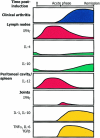The genetic and immunopathological processes underlying collagen-induced arthritis
- PMID: 11529930
- PMCID: PMC1783255
- DOI: 10.1046/j.1365-2567.2001.01267.x
The genetic and immunopathological processes underlying collagen-induced arthritis
Abstract
Animal models of rheumatoid arthritis (RA) have provided substantial insights into basic pathogenic mechanisms of chronic inflammatory arthritis and autoimmune disease in general. Of the variety of models reported, collagen-induced arthritis (CIA) has been the most characterized in terms of both its pathogenesis and its underlying immunological basis. Collagen-induced arthritis has also been the model of choice in terms of testing potential new therapeutic agents for the treatment of human RA. Nevertheless, the complex nature of the balance between T-cell cytokines and the chronic inflammatory processes is only recently becoming clear. This review focuses on these developments, highlighting their implications for our understanding of RA and for the use of CIA as a suitable animal model.
Figures


References
-
- Cathcart ES, Hayes KC, Gonnerman WA, Lazzari AA, Franzblau C. Experimental arthritis in a nonhuman primate. I. Induction by bovine type II collagen. Lab Invest. 1986;54:26–31. - PubMed
-
- Courtenay JS, Dallman MJ, Dayan AD, Martin A, Mosedale B. Immunisation against heterologous type II collagen induces arthritis in mice. Nature. 1980;283:666–8. - PubMed
Publication types
MeSH terms
Substances
LinkOut - more resources
Full Text Sources
Other Literature Sources

